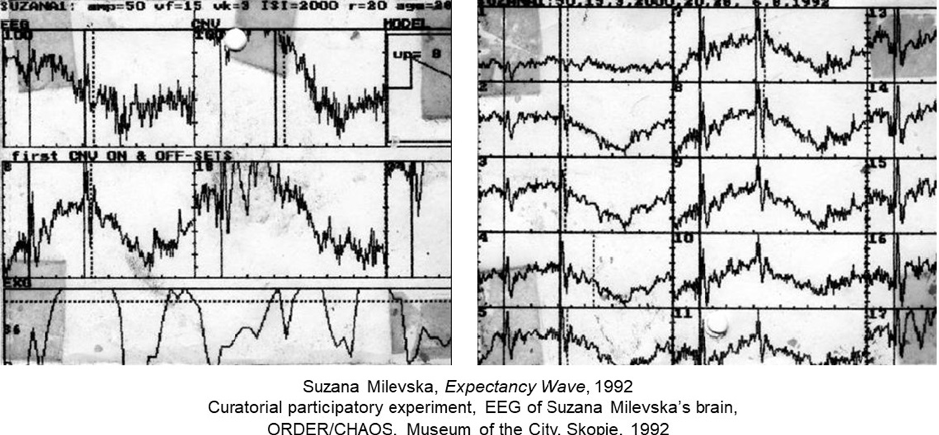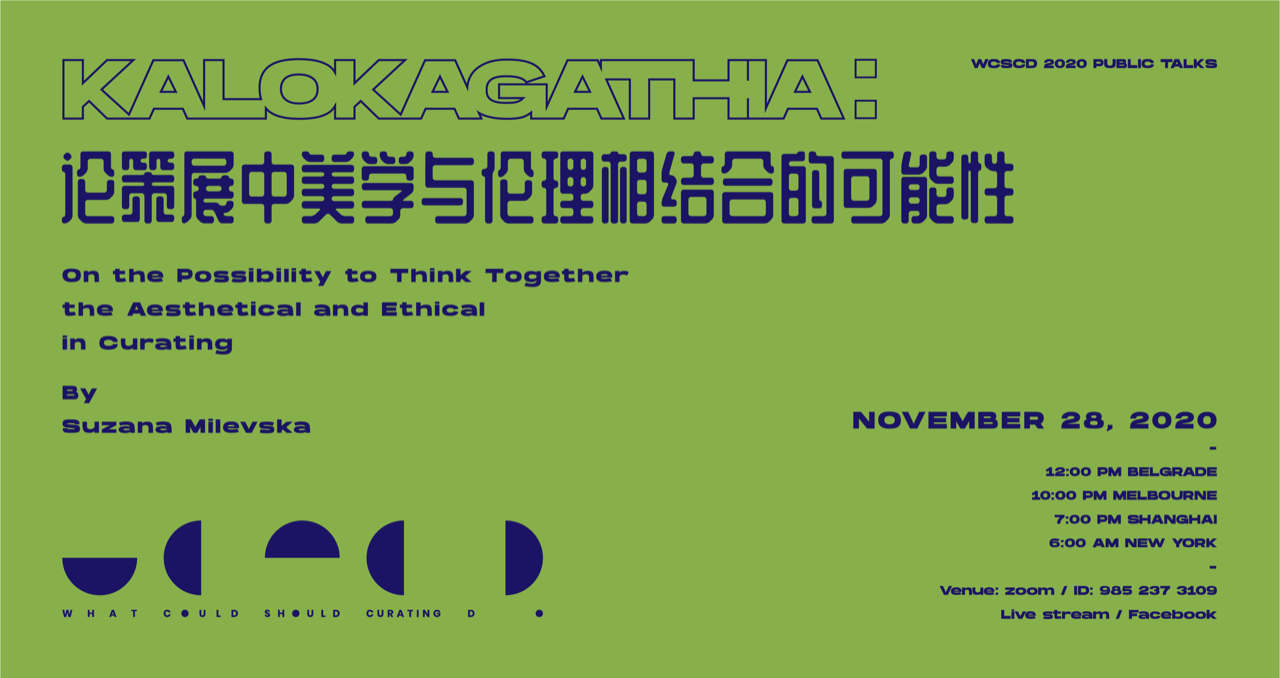The curatorial program What Could/Should Curating Do 2020 is proud to continue in 2020 with public program through lecture series
The second talk in the 2020 series is titled:
Kalokagathia: On the Possibility to Think Together the Aesthetical and Ethical in Curating
By Suzana Milevska
Date: November 28, 2020
Time: 12:00 pm Belgrade/ 10:00 pm Melbourne/ 07:00 pm Shanghai/ 6:00 am New York
Venue: zoom link ID: 985 237 3109
Live stream/Facebook link

In the lecture “Kalokagathia: On the Possibility to Think Together the Aesthetical and Ethical in Curating” Suzana Milevska will focus on the ongoing debate about the reciprocal relations and tensions between the categories of beautiful and good, between the form and content, and between other perpetual and artificially distinctions and dichotomies that emerged in art theory during modernism.
This lecture will address the questions of whether such dichotomies are and have ever been viable and how curating helps different art practices in overcoming the hierarchy between aesthetics and ethics over time. More specifically, this lecture explores the ways in which theories of curating brought back to mind the ancient Greek notion of kalokagathia, the intertwinement of aesthetics and ethics and with it, other ethical responsibilities, principles, and values that art forgot to address while giving privilege to its formal aspects.
Milevska argues that curating helps activating the catalyst potential of art without having to compromise its formal aspects, as a kind of leverage that redresses the otherwise imbalanced relationship between aesthetics and ethics. Curating in her view lends out to art its innocent and aspirational belief in such a balance because the ethical concerns in art theory and art criticism have long been toned down while form was prioritized over content. To discuss such critical position towards the phenomenon of curatorial – and to distinguish it from the curating as a profession – becomes ever more urgent in the precarious and dire pandemic period when the tensions between aesthetics and ethics, care, and self-care dominate our professional and everyday lives.
About Speaker

Portrait credit “photo Corn, Der Standard”
Dr. Suzana Milevska is a theorist and curator of visual art and culture. From 2016 to 2019 Milevska was Principal Investigator of the Horizon 2020 project TRACES, Polytechnic University Milan, and she curated its final exhibition Contentious Objects/Ashamed Subjects. She was Endowed Professor for Central and South Eastern European Art Histories at the Academy of Fine Art Vienna (2013 – 2015). She holds a PhD in visual cultures from Goldsmiths College London and in 2004 she was Fulbright Senior Research Scholar. She curated numerous international exhibitions such as; The Renaming Machine (2008-2011), Roma Protocol, Austrian Parliament, Vienna, and Call the Witness, BAK Utrecht (2011). She initiated the project Call the Witness–Roma Pavilion, Venice Biennale (2010-2011). In 2015 she curated the exhibition Inside Out: Not So White Cube, City Art Gallery, Ljubljana (with Alenka Gregorič). In 2012 she won ALICE Award for Political Curating and Igor Zabel Award for Culture and Theory. She published the books Gender Difference in the Balkans, 2010, The Renaming Machine: The Book, 2010, and On Productive Shame, Reconciliation, and Agency, SternbergPress, 2016.
WHAT COULD/SHOULD CURATING DO? (WCSCD)
WHAT COULD/SHOULD CURATING DO? (WCSCD) was initiated and funded in 2018 in Belgrade as an educational platform around notions of curatorial. From 2020 WCSCD started to initiate its own curatorial inquiries and projects that should unpack above -mentioned complexities keeping educational component as a core to the WCSCD.
The WCSCD curatorial program and series of public lectures have been initiated and organized by Biljana Ciric.
WCSCD 2020/2021 public program series has been done in collaboration with Division of Arts and Humanities, Duke Kunshan University.
Luca Lo Pinto participation in the WCSCD 2020/21 as a mentor has been supported by Instituto Italiano Di Cultura Belgrado and they are co-hosting live stream of this lecture.
Strategic media collaboration is done with Seecult and they will co-stream all public lecture series.
Project Partners

Media Partner

please click to read chinese version
WCSCD(策展可以/应该做些什么?)作为一个围绕策展概念的教育平台,于2018年在贝尔格莱德创立。自今年起,WCSCD将延续教育精神,开启自己的策展研究项目。
WCSCD的策展项目和系列公开讲座由Biljana Ciric发起并组织筹备。
WCSCD 2020/2021公共项目系列正与昆山杜克大学艺术与人文学部开展合作中,同时也将和Seecult进行战略媒体合作,联合直播所有公开系列讲座。
WCSCD 2020系列第二场公开讲座将以Kalokagathia:论策展中美学与伦理相结合的可能性为题,邀请视觉艺术和文化的理论家和策展人Suzana Milevska博士主讲。
时间:11月28日 北京时间晚7点
Zoom会议号:985 237 3109
Kalokagathia:论策展中美学与伦理相结合的可能性
在讲座《Kalokagathia:论策展中美学与伦理相结合的可能性》中,Suzana Milevska将集中讨论有关美与善之间、形式与内容之间、以及在现代主义艺术理论中出现的永久和人为之间的区别和二分法。
本讲座将探讨以下问题:这种二分法在现在或过去是否可行;随着时间的流逝,策展如何帮助不同的艺术实践解决美学与伦理之间的等级关系问题。更具象地说,本讲座探讨了策展理论将古希腊kalokagathia(至善至美)、美学与伦理学交织的概念、以及艺术在赋予其特权时忘记解决的其他道德责任、原则与价值观带回人们视野的方式。
Milevska认为,策展有助于激活艺术的催化剂潜力,而不必牺牲其形式方面,策展作为杠杆,能够矫正美学与伦理之间不平衡的关系。因为长期以来,艺术理论和艺术批评中的伦理问题被淡化,形式被优先于内容,在她看来,策展的这种天真和理想的信念有助于艺术的这种平衡。在不稳定和可怕的新冠肺炎疫情时期,当美学与伦理、关怀和自我关怀之间的紧张关系支配着我们的职业和日常生活时,讨论这种对策展现象的批判性立场并将其与作为一种职业的策展人加以区分变得更加迫切。
关于主讲人
Suzana Milevska博士是视觉艺术和文化的理论家和策展人。Milevska在2016至2019年间担任米兰理工大学地平线2020项目跟踪项目的首席研究员,并策划了最后一次展览“有争议的物体/羞耻的主题”。她曾在2013至2015年间任教于维也纳美术学院,教授中欧和东南欧艺术史教授。她在伦敦大学金匠学院取得视觉文化博士学位,并于2004年担任富布赖特项目高级研究学者。她曾策划过许多国际展览,例如:《更名机》(The Renaming Machine)(2008-2011年),《罗马议定书》(Roma Protocol),《奥地利议会》(Austrian Parliament),《维也纳》(Vienna)和《见证人》(Call the Witness),乌克特比克(2011年)。2015年,她在卢布尔雅那市艺术画廊与Alenka Gregorič一起策划了展览《由内而外:并非白立方》(Inside Out: Not So White Cube)。2012年,她获得了ALICE政治策划奖和Igor Zabel文化与理论奖。她于2010年出版《巴尔干地区的性别差异》(Gender Difference in the Balkans),《更名的机器:书籍》(The Renaming Machine: The Book);并于2016年在Sternberg出版社发表《关于生产耻辱,和解与代理》(On Productive Shame, Reconciliation, and Agency)。
For more information about the program, please refer to www.old.wcscd.com
Project contacts: what.could.curating.do@gmail.com
Follow us:
FB: @whatcscdo
Instagram: @whatcouldshouldcuratingdo
previous lectures
Practices of Care: On Rehumanization and Curating | Where is the body of the curator? | From steirischer herbst to Paranoia TV: one festival reinventing itself | Reimagining the museum

